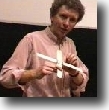The Wikipedia page
Wikipedia: Gyroscope
The Wikipedia article opens with the paragraph
"A gyroscope is a device for measuring or maintaining orientation, based on the principles of angular momentum.
A mechanical gyroscope is essentially a spinning wheel or disk whose axle is free to take any orientation.
This orientation changes much less in response to a given external torque than it would without the large angular
momentum associated with the gyroscope's high rate of spin. Since external torque is minimized by mounting the
device in gimbals, its orientation remains nearly fixed, regardless of any motion of the platform on which it
is mounted. Solid state gyroscopes also exist."
This is in fact a description of a "gyrostat" and so is incorrect as a description of a gyroscope.
If the orientation of a gyro is fixed then it is incapable of measuring or influencing orientation - yet most
applications of gyros are within a control system where the orientation is not fixed. This is especially true of
strapdown systems. The idea that "solid state gyroscopes also exist" is incorrect. A "solid state gyro" is not a rotor
on gimbals. It is a device for measuring rotation and it usually employs a vibrating beam, or perhaps a laser ring.
Virtual Gyroscopes
To see Laithwaite's demonstrations with clear explanations go to Emma Wilson's
Virtual Gyroscope page
There are plenty of wonderful observations to be made with gyroscopes, and all can be explained with the
application of Newton's Laws of motion, in particular F=ma. The catch is that F=ma applies to the motion of a particle
and a spinning disc is a rigid body. The motion of rigid bodies needs to be deduced as the integrated sum of the motion of
all its component particles. Truly wonderful stuff!
Boomerangs
The boomerang is governed by the gyroscopic effect and aerodynamic lift - two of the most mis-understood areas of physics.
This page provides links which I hope will demystify much of the behaviour of boomerangs.
Unspinning the boomerang:
 Boomerangs for dummies
Boomerangs for dummies
Make your own cross-shaped boomerang:
 Bang up a boomerang
Bang up a boomerang
Making cross-shaped boomerangs is easy: Click here: How to make a boomerang for a one-page handout suitable for printing
Make and throw a big boomerang:
 watch video here
watch video here
Boomerang Theory:
 Simplified boomerang theory and
Detailed mathematics
Simplified boomerang theory and
Detailed mathematics
Boomerang Movies
National Science Week Schools Roadshow
Here is a link to a fun news bulletin on Boomerangs in Trinity College Cambridge and
lectures to Schools for the National Science Week Schools Roadshow.
 Available either as
Available either as
 WMV, 2.2MB or
AVI, 8MB
WMV, 2.2MB or
AVI, 8MB
 (playing time = 3 minutes)
(playing time = 3 minutes)
Other clips are at WMV1 (1.6MB)
and at WMV3 (0.3MB).
Trinity College Science Society Lecture
Boomerangs, bouncing balls and other spinning things.
TCSS Lecture (1 hour, WMV format)
| 

![[Univ of Cambridge]](http://www.eng.cam.ac.uk/images/house_style/uniban-s.gif)

![[Dept of Engineering]](http://www.eng.cam.ac.uk/images/house_style/engban-s.gif)


